YAMAHA FX HO CRUISER 2022 User Guide
Manufacturer: YAMAHA, Model Year: 2022, Model line: FX HO CRUISER, Model: YAMAHA FX HO CRUISER 2022Pages: 136, PDF Size: 5.62 MB
Page 11 of 136
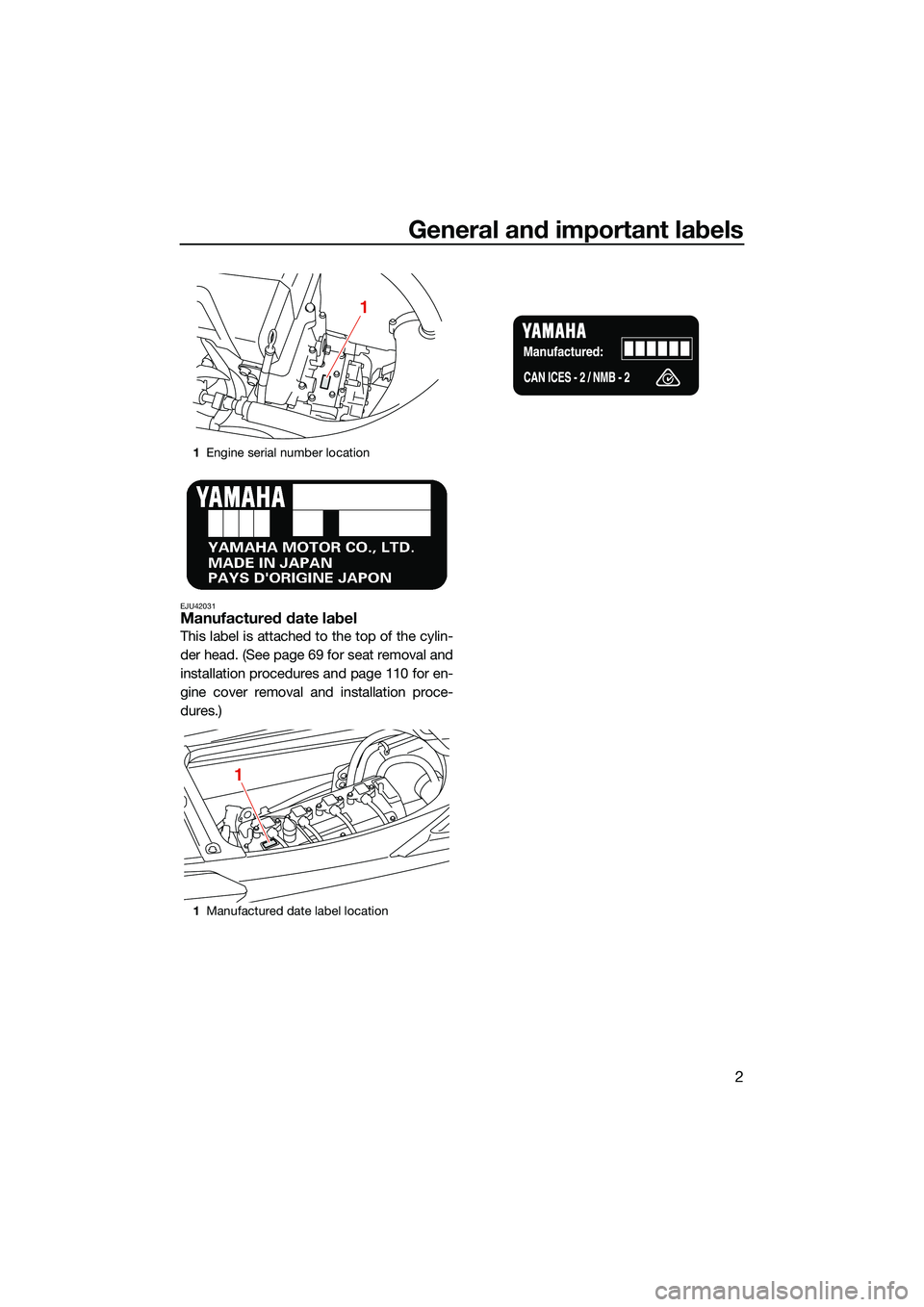
General and important labels
2
EJU42031Manufactured date label
This label is attached to the top of the cylin-
der head. (See page 69 for seat removal and
installation procedures and page 110 for en-
gine cover removal and installation proce-
dures.)
1Engine serial number location
1 Manufactured date label location
1
1
UF3V73E0.book Page 2 Friday, October 8, 2021 1:30 PM
Page 12 of 136
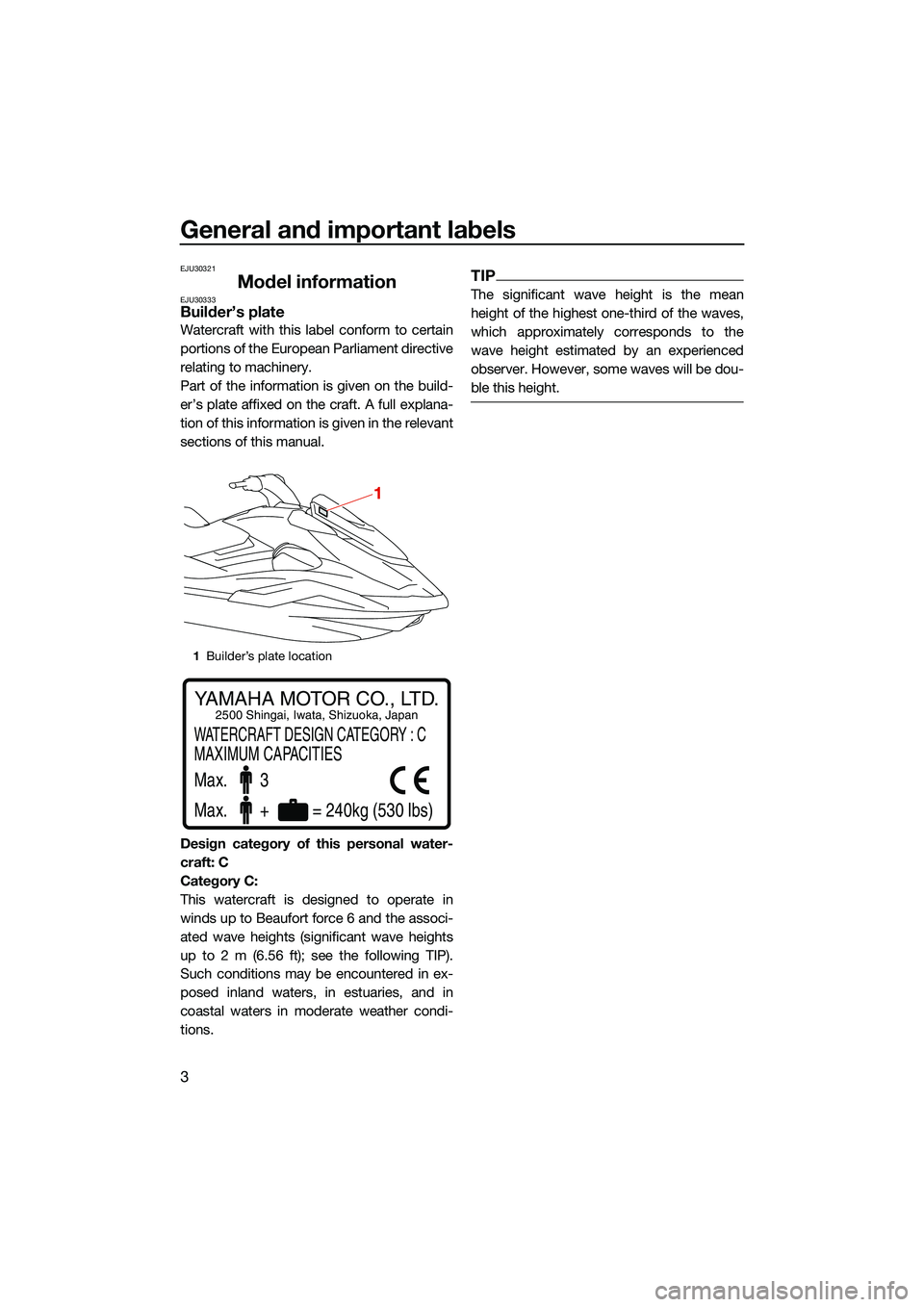
General and important labels
3
EJU30321
Model informationEJU30333Builder’s plate
Watercraft with this label conform to certain
portions of the European Parliament directive
relating to machinery.
Part of the information is given on the build-
er’s plate affixed on the craft. A full explana-
tion of this information is given in the relevant
sections of this manual.
Design category of this personal water-
craft: C
Category C:
This watercraft is designed to operate in
winds up to Beaufort force 6 and the associ-
ated wave heights (significant wave heights
up to 2 m (6.56 ft); see the following TIP).
Such conditions may be encountered in ex-
posed inland waters, in estuaries, and in
coastal waters in moderate weather condi-
tions.
TIP
The significant wave height is the mean
height of the highest one-third of the waves,
which approximately corresponds to the
wave height estimated by an experienced
observer. However, some waves will be dou-
ble this height.
1Builder’s plate location
1
YAMAHA MOTOR CO., LTD.
WATERCRAFT DESIGN CATEGORY : C
MAXIMUM CAPACITIES
2500 Shingai, Iwata, Shizuoka, Japan
Max. 3
Max. + = 240kg (530 lbs)
UF3V73E0.book Page 3 Friday, October 8, 2021 1:30 PM
Page 13 of 136
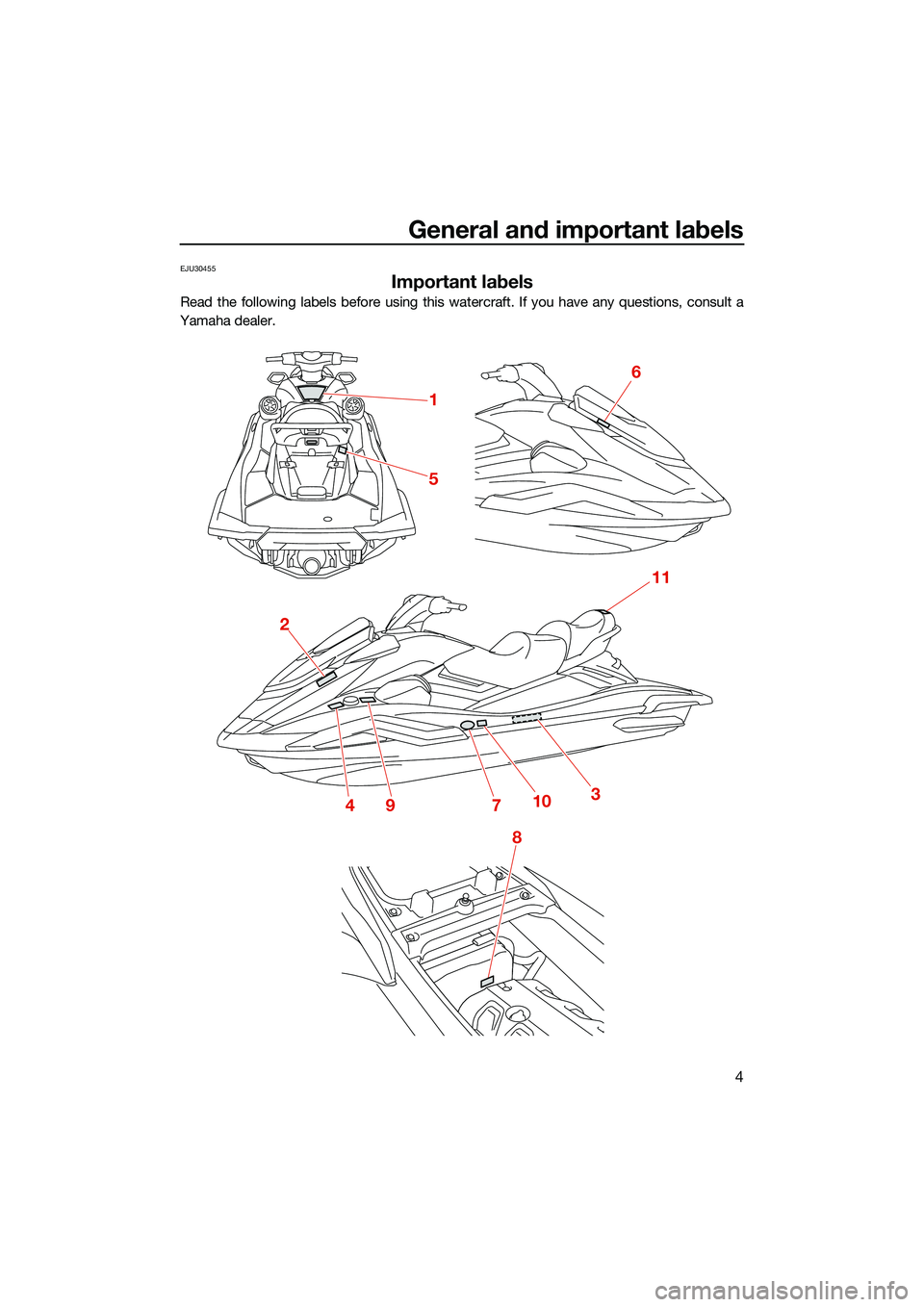
General and important labels
4
EJU30455
Important labels
Read the following labels before using this watercraft. If you have any questions, consult a
Yamaha dealer.
1
5
2
8
491037
6
11
UF3V73E0.book Page 4 Friday, October 8, 2021 1:30 PM
Page 14 of 136
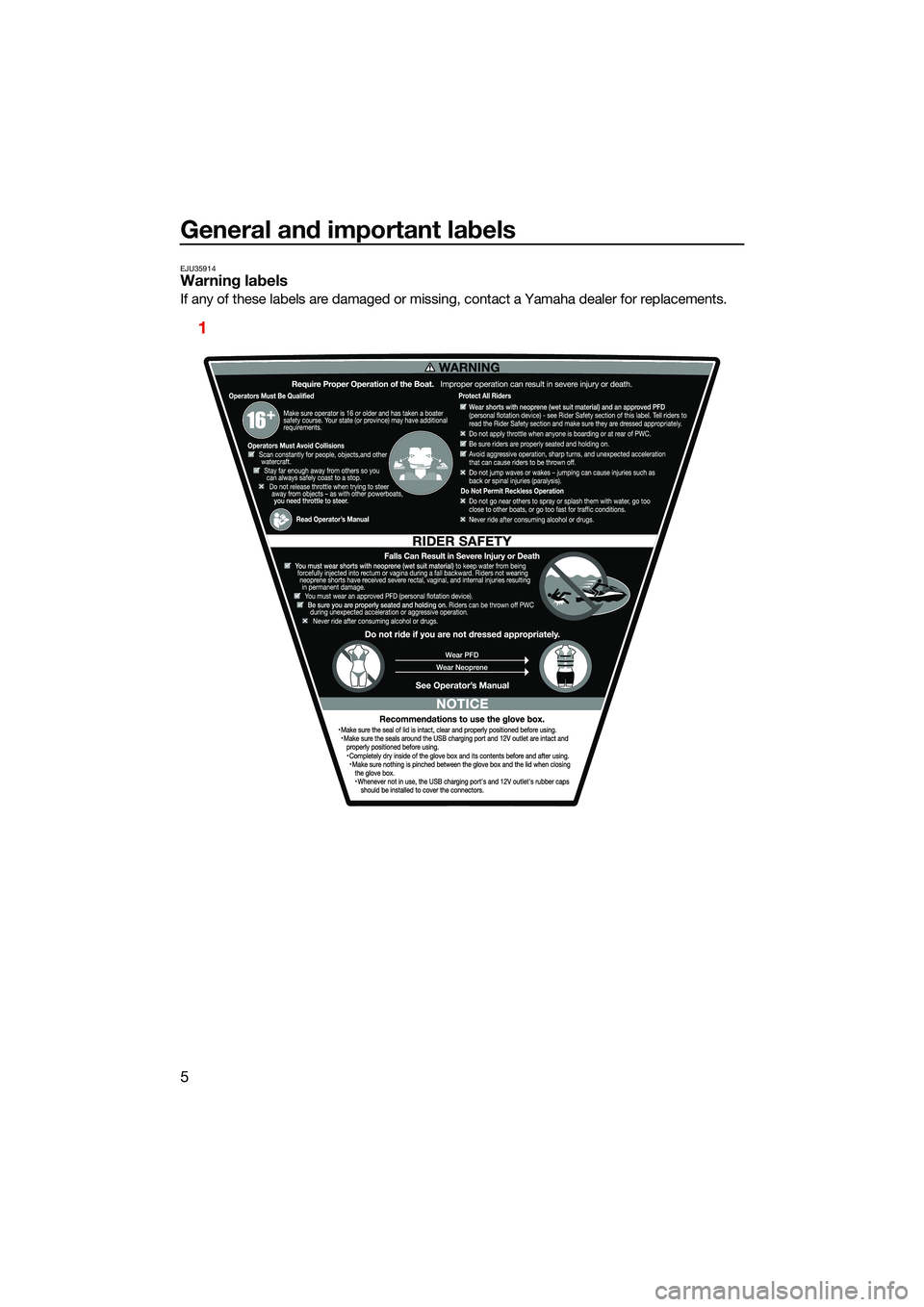
General and important labels
5
EJU35914Warning labels
If any of these labels are damaged or missing, contact a Yamaha dealer for replacements.
1
UF3V73E0.book Page 5 Friday, October 8, 2021 1:30 PM
Page 15 of 136
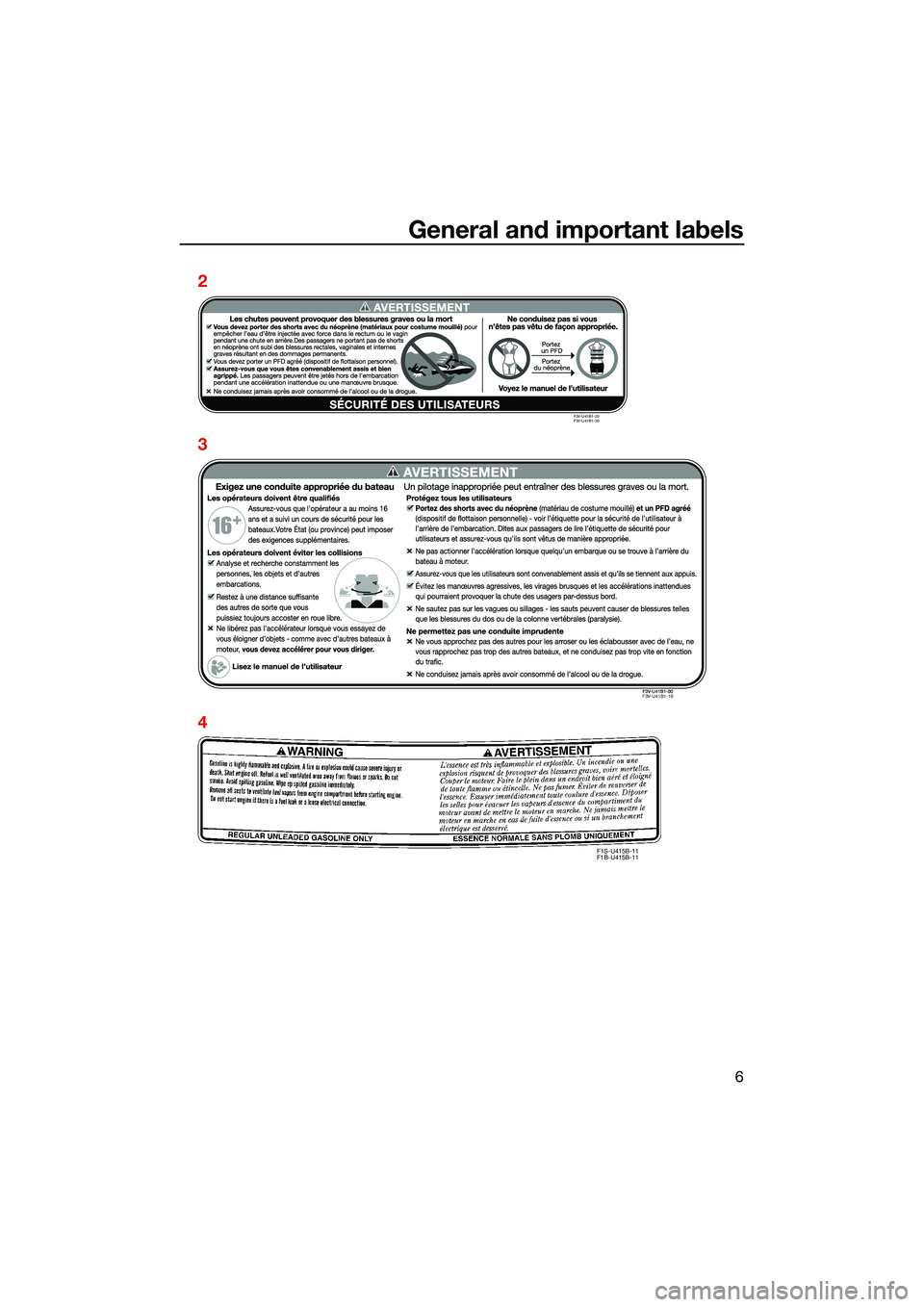
General and important labels
6
F1S-U415B-11
F1B-U415B-11
2
3
4
F3V-U41B1-20
F3V-U41B1-30
F3V-U41B1-10
UF3V73E0.book Page 6 Friday, October 8, 2021 1:30 PM
Page 16 of 136
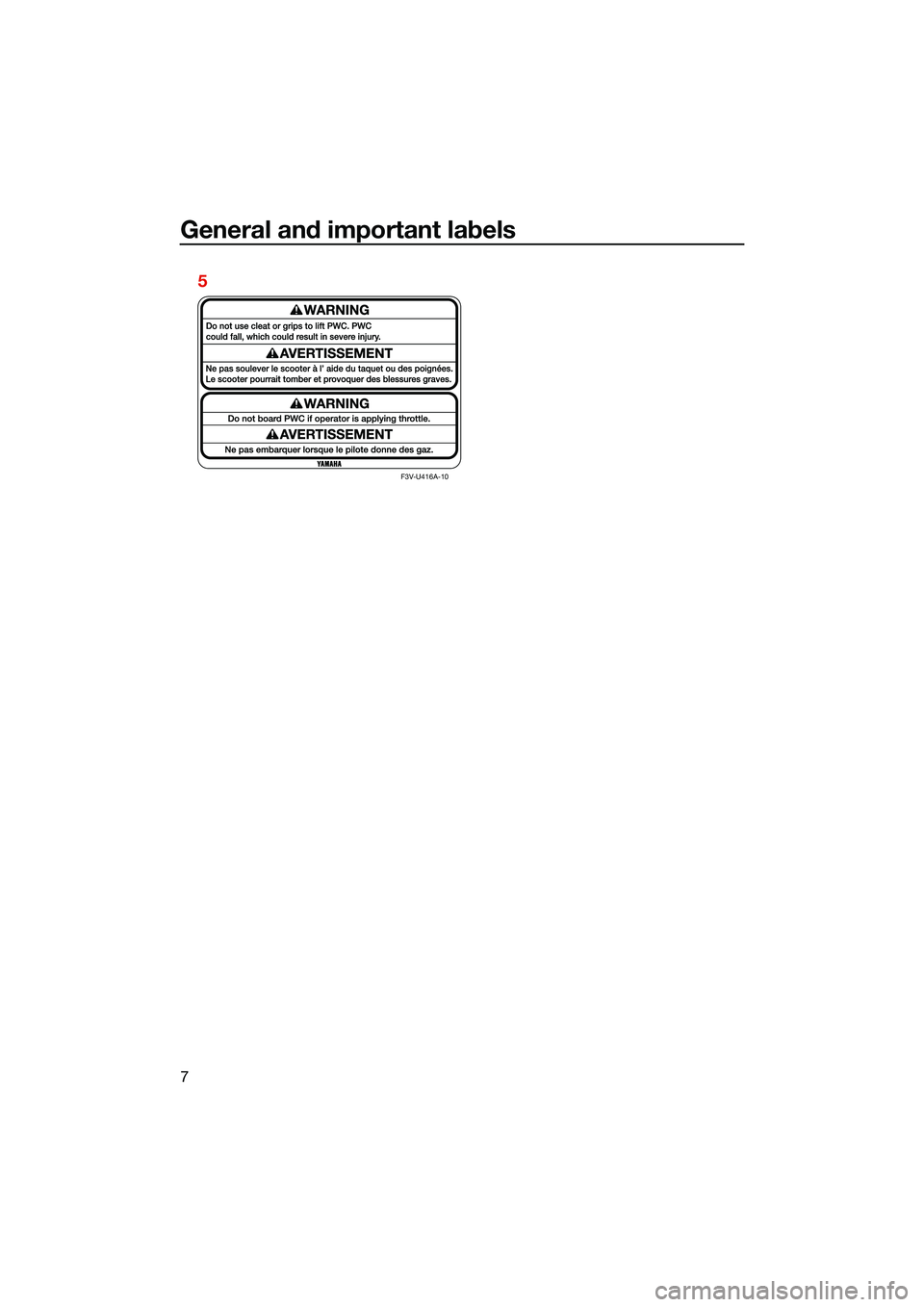
General and important labels
7
5
F3V-U416A-10
UF3V73E0.book Page 7 Friday, October 8, 2021 1:30 PM
Page 17 of 136
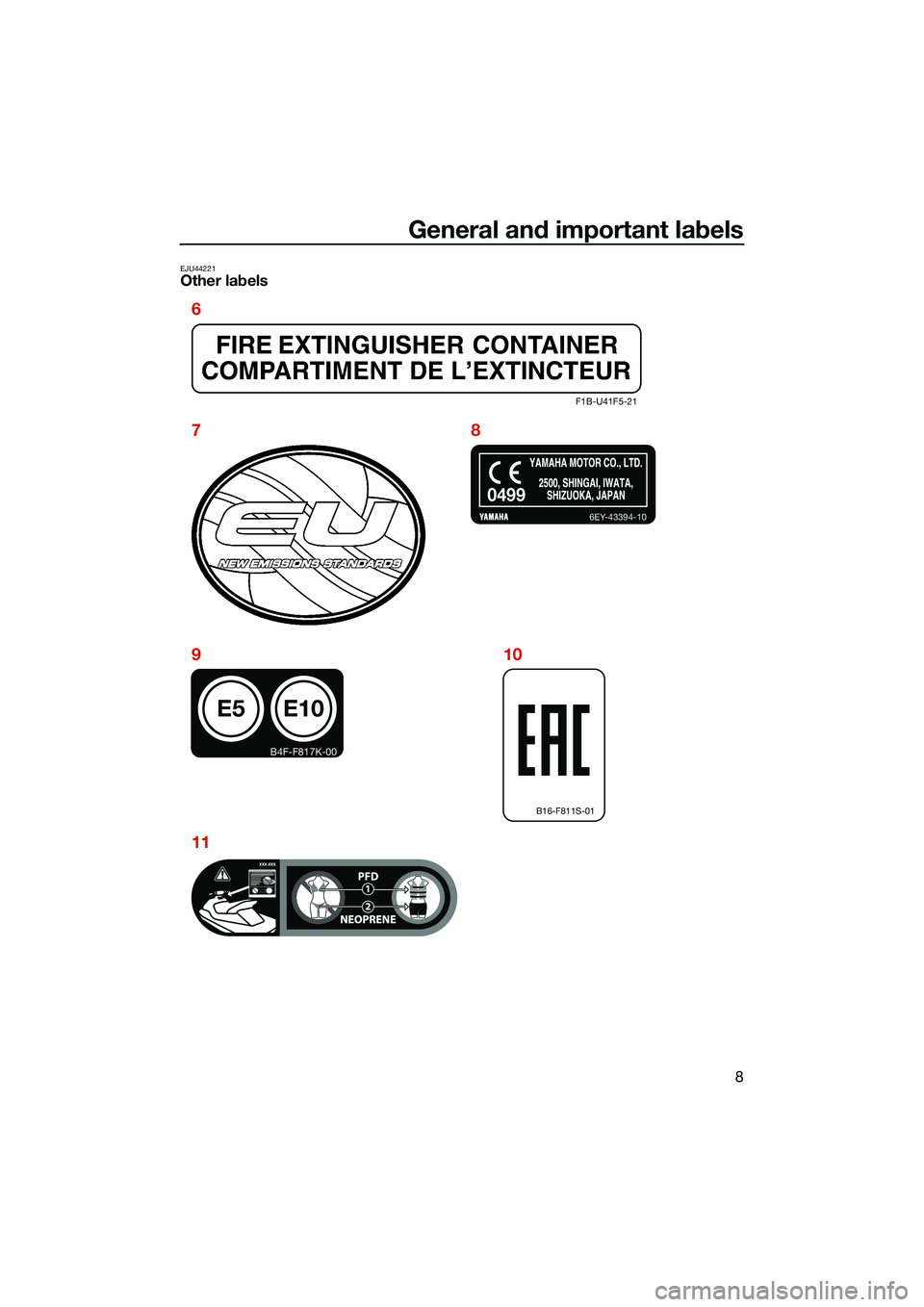
General and important labels
8
EJU44221Other labels
F1B-U41F5-21
6EY-43394-10
E5
B4F-F817K-00
E10
0499
B16-F811S-01
6
78
9
1110
UF3V73E0.book Page 8 Friday, October 8, 2021 1:30 PM
Page 18 of 136

Safety information
9
EJU30683
The safe use and operation of this water-
craft is dependent upon the use of proper
riding techniques, as well as upon the
common sense, good judgment, and ex-
pertise of the operator. Before using this
watercraft, make sure that its use is per-
mitted under local laws, bylaws, and regu-
lations, and always operate the watercraft
in full conformity with any requirements
and limitations imposed. Every operator
should know the following requirements
before riding the watercraft.
Before operating the watercraft, read this
owner’s/operator’s manual, the Riding
Practice Guide, the Riding Instruction card,
and all labels on the watercraft. These ma-
terials should give you an understanding of
the watercraft and its operation.
Never allow anyone to operate this water-
craft until they too have read this own-
er’s/operator’s manual, the Riding Practice
Guide, the Riding Instruction card, and all
labels.
EJU30743
Limitations on who may operate the watercraft
Make sure that the operator is 16 years of
age or older and has taken a boater safety
course.
Adults must supervise use by minors.
This watercraft is designed to carry the op-
erator and up to 2 passengers. Never ex-
ceed the maximum load limit or allow more
than 3 persons (or 2 persons if a wake-
boarder or water-skier is being pulled) to
ride the watercraft at any time.
Do not operate the watercraft with any pas-
sengers on board until you have consider-
able practice and experience riding alone.
Operating the watercraft with passengers
requires more skill. Take the time to be-
come accustomed to the handling charac-
teristics of the watercraft before trying any
difficult maneuvers.Maximum load:
240 kg (530 lb)
Load is the total weight of cargo, op-
erator, and passengers.
UF3V73E0.book Page 9 Friday, October 8, 2021 1:30 PM
Page 19 of 136
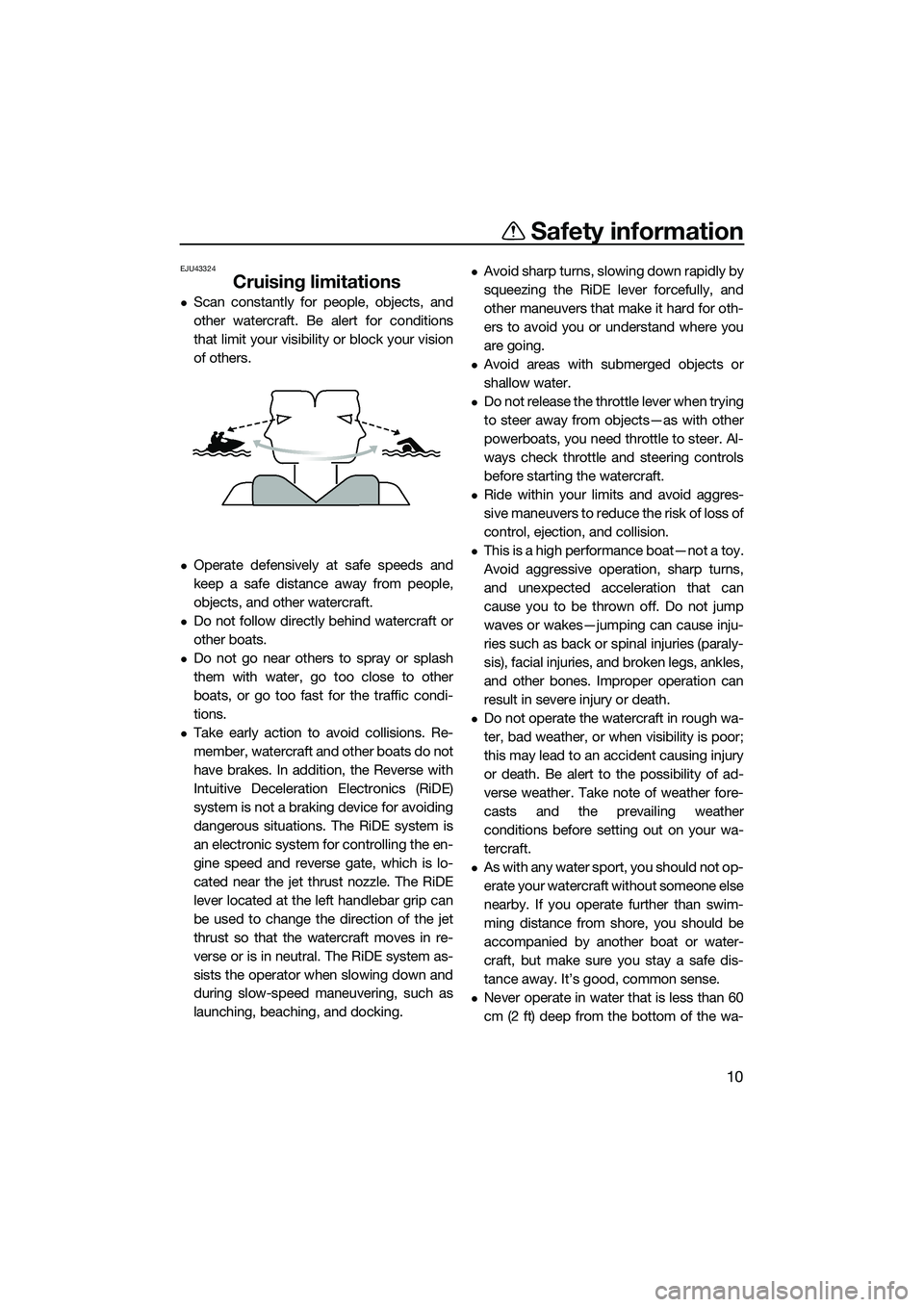
Safety information
10
EJU43324
Cruising limitations
Scan constantly for people, objects, and
other watercraft. Be alert for conditions
that limit your visibility or block your vision
of others.
Operate defensively at safe speeds and
keep a safe distance away from people,
objects, and other watercraft.
Do not follow directly behind watercraft or
other boats.
Do not go near others to spray or splash
them with water, go too close to other
boats, or go too fast for the traffic condi-
tions.
Take early action to avoid collisions. Re-
member, watercraft and other boats do not
have brakes. In addition, the Reverse with
Intuitive Deceleration Electronics (RiDE)
system is not a braking device for avoiding
dangerous situations. The RiDE system is
an electronic system for controlling the en-
gine speed and reverse gate, which is lo-
cated near the jet thrust nozzle. The RiDE
lever located at the left handlebar grip can
be used to change the direction of the jet
thrust so that the watercraft moves in re-
verse or is in neutral. The RiDE system as-
sists the operator when slowing down and
during slow-speed maneuvering, such as
launching, beaching, and docking.
Avoid sharp turns, slowing down rapidly by
squeezing the RiDE lever forcefully, and
other maneuvers that make it hard for oth-
ers to avoid you or understand where you
are going.
Avoid areas with submerged objects or
shallow water.
Do not release the throttle lever when trying
to steer away from objects—as with other
powerboats, you need throttle to steer. Al-
ways check throttle and steering controls
before starting the watercraft.
Ride within your limits and avoid aggres-
sive maneuvers to reduce the risk of loss of
control, ejection, and collision.
This is a high performance boat—not a toy.
Avoid aggressive operation, sharp turns,
and unexpected acceleration that can
cause you to be thrown off. Do not jump
waves or wakes—jumping can cause inju-
ries such as back or spinal injuries (paraly-
sis), facial injuries, and broken legs, ankles,
and other bones. Improper operation can
result in severe injury or death.
Do not operate the watercraft in rough wa-
ter, bad weather, or when visibility is poor;
this may lead to an accident causing injury
or death. Be alert to the possibility of ad-
verse weather. Take note of weather fore-
casts and the prevailing weather
conditions before setting out on your wa-
tercraft.
As with any water sport, you should not op-
erate your watercraft without someone else
nearby. If you operate further than swim-
ming distance from shore, you should be
accompanied by another boat or water-
craft, but make sure you stay a safe dis-
tance away. It’s good, common sense.
Never operate in water that is less than 60
cm (2 ft) deep from the bottom of the wa-
UF3V73E0.book Page 10 Friday, October 8, 2021 1:30 PM
Page 20 of 136
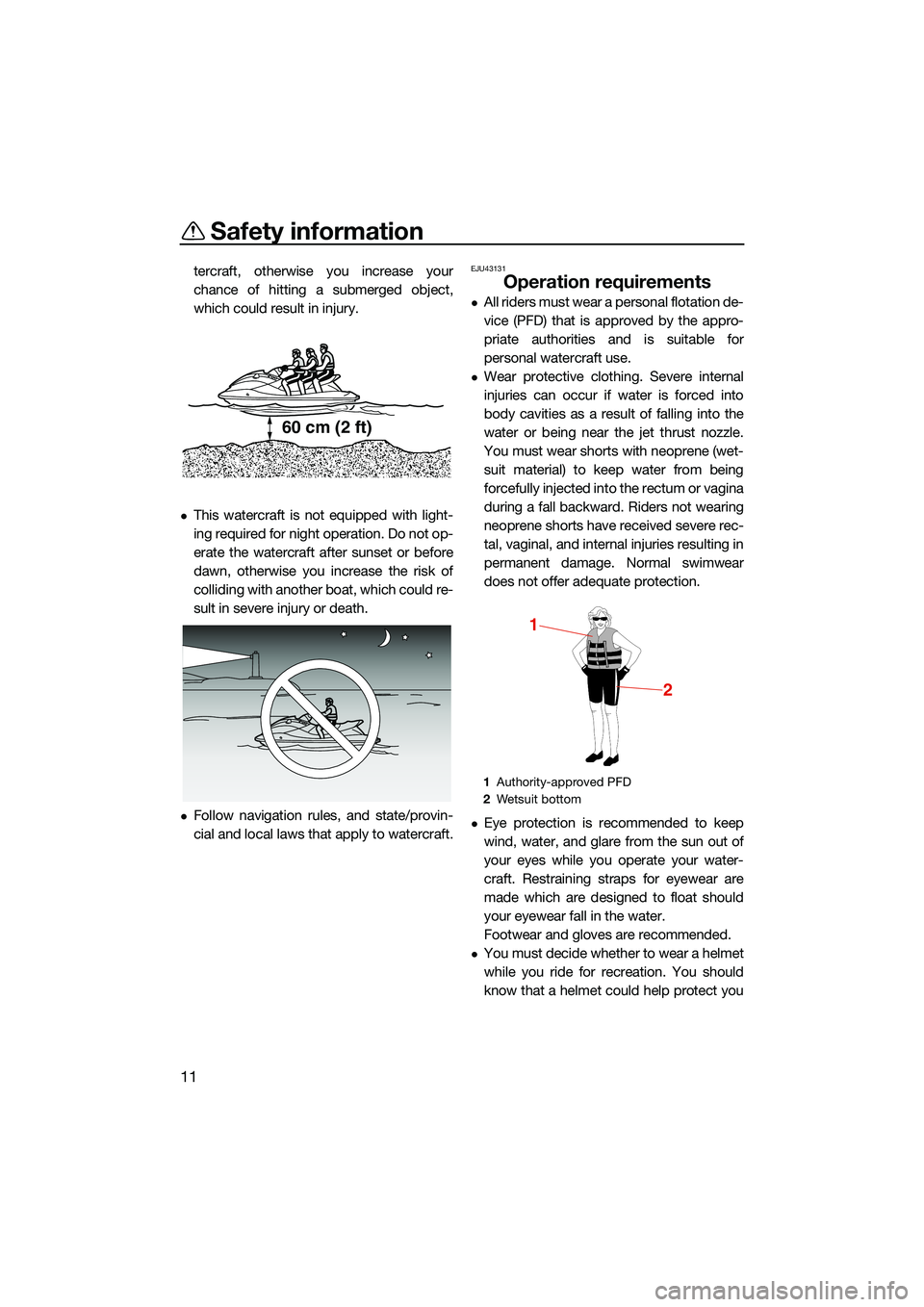
Safety information
11
tercraft, otherwise you increase your
chance of hitting a submerged object,
which could result in injury.
This watercraft is not equipped with light-
ing required for night operation. Do not op-
erate the watercraft after sunset or before
dawn, otherwise you increase the risk of
colliding with another boat, which could re-
sult in severe injury or death.
Follow navigation rules, and state/provin-
cial and local laws that apply to watercraft.
EJU43131
Operation requirements
All riders must wear a personal flotation de-
vice (PFD) that is approved by the appro-
priate authorities and is suitable for
personal watercraft use.
Wear protective clothing. Severe internal
injuries can occur if water is forced into
body cavities as a result of falling into the
water or being near the jet thrust nozzle.
You must wear shorts with neoprene (wet-
suit material) to keep water from being
forcefully injected into the rectum or vagina
during a fall backward. Riders not wearing
neoprene shorts have received severe rec-
tal, vaginal, and internal injuries resulting in
permanent damage. Normal swimwear
does not offer adequate protection.
Eye protection is recommended to keep
wind, water, and glare from the sun out of
your eyes while you operate your water-
craft. Restraining straps for eyewear are
made which are designed to float should
your eyewear fall in the water.
Footwear and gloves are recommended.
You must decide whether to wear a helmet
while you ride for recreation. You should
know that a helmet could help protect you
60 cm (2 ft)
1Authority-approved PFD
2 Wetsuit bottom
1
2
UF3V73E0.book Page 11 Friday, October 8, 2021 1:30 PM